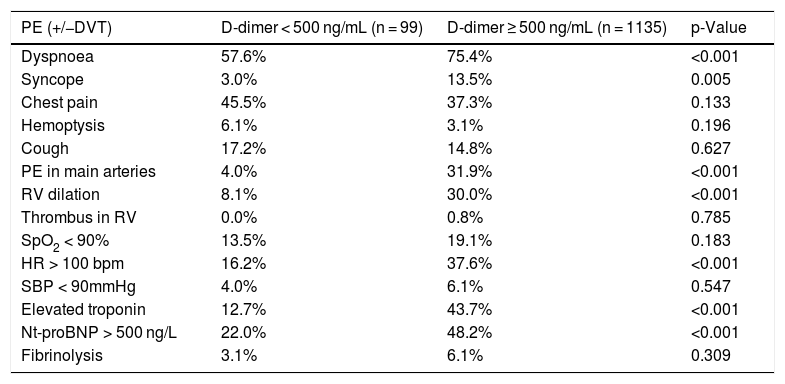D-dimer has a high negative predictive value for the diagnosis of venous thromboembolic disease (VTE). However, VTE has been reported in the presence of normal D-dimer values.
MethodsThis is a prospective observational study in patients with VTE from Hospital Gregorio Marañón between 2001–2022, comparing the characteristics of clinical presentation based on D-dimer levels (<500 ng/mL vs. ≥ 500 ng/mL).
ResultsA total of 2582 patients were found, 333 patients (12.9%) presented negative or weakly positive D-dimer levels. They were significantly younger (57.9 vs. 65.3 years), with a lower prevalence of comorbidities (ischemic heart disease, dementia, and chronic kidney disease), and a greater family history of VTE (8.4% vs. 5.2%) and thrombophilia (11.7% vs. 7.8%). They presented significantly less dyspnea (57.6% vs. 75.4%), syncope (3% vs. 13.5%), less thrombotic load, elevated NT-pro-BNP (22.0% vs. 48.2 %), and right ventricle dilatation (8.1% vs. 30.0%).
ConclusionPatients with VTE and low D-dimer levels at diagnosis were younger, with milder clinical presentation and lower thrombotic load; but they presented a higher prevalence of thrombophilia and a family history of VTE.
El dímero-D presenta un elevado valor predictivo negativo para el diagnóstico de enfermedad tromboembólica venosa (ETV). Sin embargo, se ha descrito ETV en presencia de valores normales de dímero-D.
Pacientes y métodosEstudio observacional prospectivo en pacientes con ETV en el Hospital Gregorio Marañón entre 2001–2022 que compara las características de presentación clínica en función de los niveles de dímero-D (<500 ng/mL vs. ≥500 ng/mL).
ResultadosDel total de 2582 pacientes, 333 pacientes (12,9%) presentaron dímero-D negativo o débilmente positivo. Estos eran significativamente más jóvenes (57,9 vs. 65,3 años), con menor prevalencia de comorbilidades (cardiopatía isquémica, demencia y enfermedad renal crónica), mayor historia familiar de ETV (8,4% vs. 5,2%) y trombofilia (11,7% vs. 7,8%). Presentaron significativamente menor disnea (57,6% vs. 75,4%), síncope (3% vs. 13,5%), menor carga trombótica, elevación de Nt-pro-BNP (22,0% vs. 48,2%) y dilatación del ventrículo derecho (8,1% vs. 30,0%).
ConclusiónLos pacientes con ETV y niveles bajos de dímero-D al diagnóstico fueron más jóvenes, con presentación clínica más leve y menor carga trombótica; pero presentaron mayor prevalencia de trombofilia e historia familiar de ETV.









